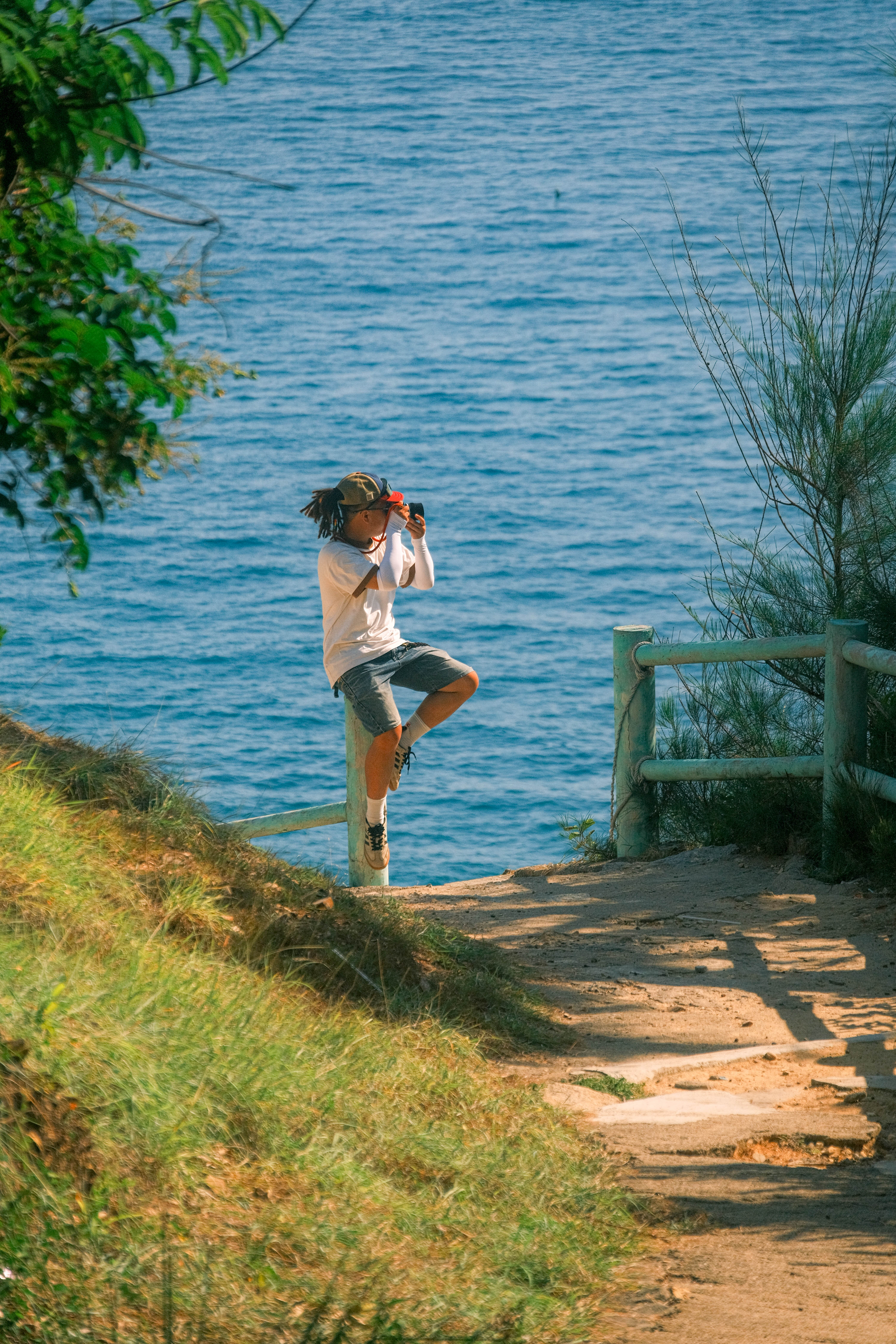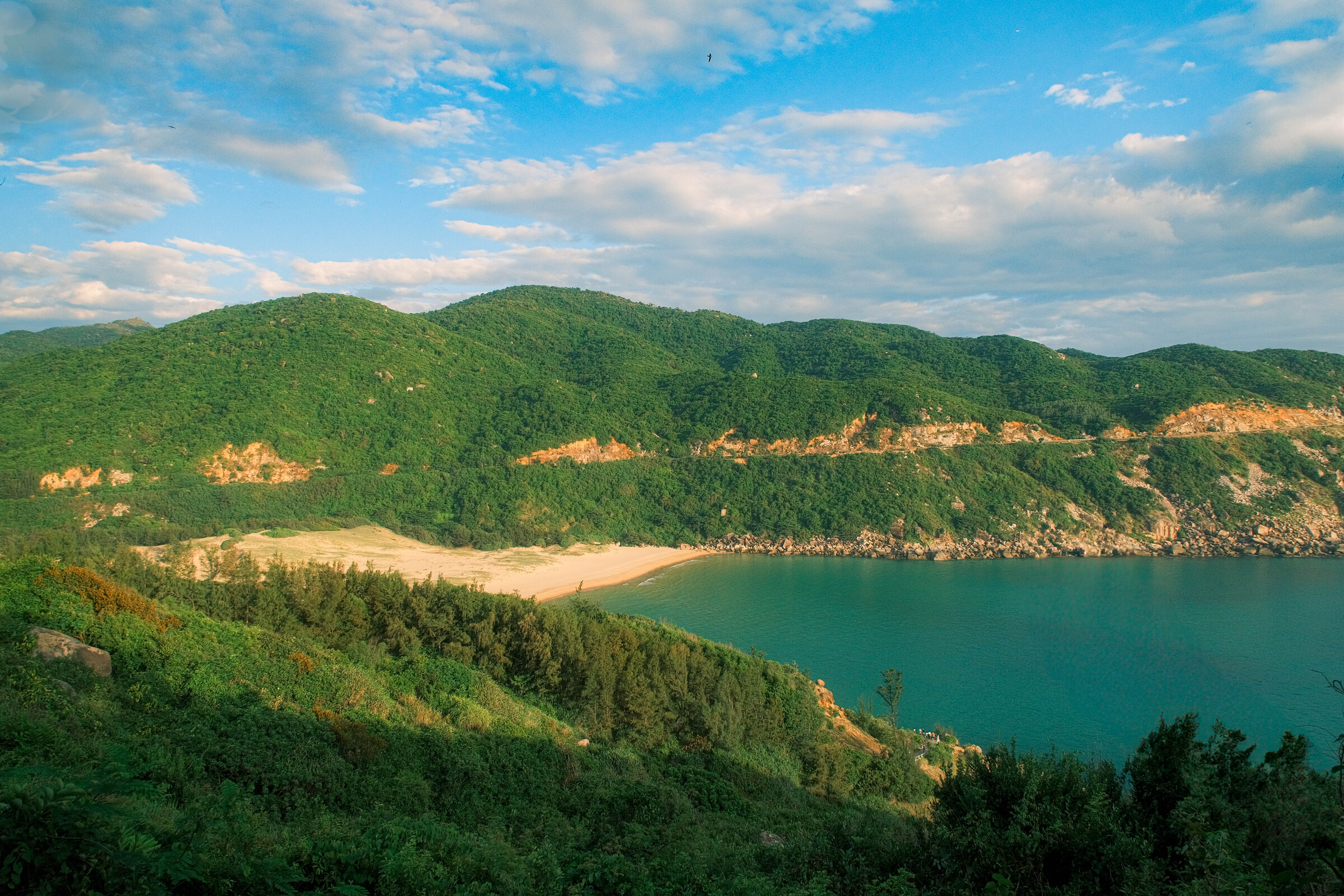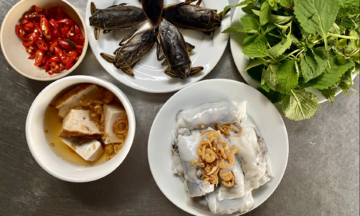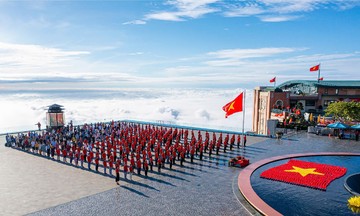Mui Dien, also known as Dai Lanh Cape, is located in Phuoc Tan Hamlet, Phu Yen Ward, Dak Lak Province. It's one of the first two places on the mainland of Vietnam to greet the dawn, along with Mui Doi in Khanh Hoa Province. The area's limited tourism development has preserved its pristine beauty and tranquility. Towering cliffs, sedimentary rock formations jutting into the bay, and a smooth white-sand beach embracing the turquoise water create an ideal setting for a summer getaway.
 |
A corner of Dai Lanh Lighthouse. Photo: Quang Anh |
This 48-hour itinerary for Mui Dien is based on Quang Anh's early July experience and insights from a VnExpress reporter.
Day 1
Traveling from Tuy Hoa
Visitors from Hanoi, Ho Chi Minh City, and other locations should choose an early morning flight to Tuy Hoa to maximize sightseeing time. Alternatively, overnight buses or trains are available from neighboring provinces for those with more flexible schedules. Train and bus fares range from approximately 300,000 to 1,700,000 VND per person, one way, depending on the point of departure.
Mui Dien is about 40 km from Tuy Hoa city center. However, large buses typically bypass the coastal route, opting for National Highway 1A. Visitors can spend the first day relaxing and exploring Tuy Hoa's culinary scene, then rent a motorbike or take a taxi from the city center the next day to begin their journey to Mui Dien along one of Vietnam's most scenic coastal roads. Alternatively, visitors can explore Deo Ca Pass and Vung Ro Bay and choose to stay overnight near Mui Dien to witness the sunrise early the following morning.
Exploring Deo Ca Pass and Vung Ro Bay
Deo Ca Pass, about 40 km from Tuy Hoa city center, is located on National Highway 1, cutting across the Dai Lanh mountain range at the border between Phu Yen and Khanh Hoa provinces. The pass is approximately 333 m high and 12 km long, with its peak in Vung Ro Hamlet, Hoa Xuan Nam Commune.
Looking east from the peak of the pass, one can see Vung Ro Bay nestled amidst a crescent-shaped mountain range. The bay, covering an area of about 16.4 km2, serves as a natural sea border between the two provinces. It's surrounded by three mountain ranges: Deo Ca to the north, Da Bia to the east, and Hon Ba to the west, while Hon Nua Island shields it from the south.
Vung Ro Bay played a vital role during the war as a landing point for the "Nameless Ships" that transported supplies to the southern battlefront. In 2013, the Vietnam Records Organization recognized it as one of the 10 most beautiful bays in the country. The area boasts 12 smaller, pristine beaches, ideal for exploration and relaxation.
Visitors can dine on fresh seafood at the floating restaurants here, with prices ranging from 200,000 to 500,000 VND per person.
Exploring Tuy Hoa's culinary scene
Tuy Hoa, a notable stop in Dak Lak, offers diverse and affordable dining options compared to other coastal destinations. With 100,000 VND a day, you can sample most of the local specialties.
From morning to afternoon, explore local favorites like banh hoi long heo (pork offal with rice vermicelli), chicken rice, bun ca (fish noodle soup), and banh canh he (thick noodle soup with water spinach).
Quang Anh also recommends Phu Yen's banh xeo (savory crepe). These small, crispy crepes, distinct for their white color due to the absence of turmeric powder, are priced between 8,000 and 12,000 VND each, depending on the filling. They are widely available throughout Tuy Hoa, with consistent quality.
In the evening, stroll along Le Duan and Doc Lap streets to enjoy fresh seafood like grilled squid, steamed shrimp, scallops baked with mo hanh (scallion oil), tuna eyes, or tuna sashimi. Prices range from 200,000 to 500,000 VND per person.
Also, try local desserts and drinks like soy milk, che dau thap cam (mixed bean sweet soup), and che sam bo luong (herbal sweet soup). An evening of street food exploration in Tuy Hoa typically costs under 100,000 VND per person. You can also find local specialties like dried squid, fried fish cakes, and dac seed to enjoy or take home as souvenirs.
For overnight stays in Tuy Hoa, budget-friendly hotels and guesthouses in the city center range from 150,000 to 300,000 VND per night. Luxury options include Rosa Alba Resort, Sala Grand Tuy Hoa Hotel, and Saigon Phu Yen Hotel, with prices from 700,000 to 5,000,000 VND per night.
Day 2
Sunrise at Mui Dien
From Tuy Hoa, rent a motorbike for an early morning departure, or stay overnight near Mui Dien or the Dai Lanh border post for convenient sunrise viewing.
Previously, reaching Mui Dien Lighthouse required traversing a mountain trail. Now, a paved road facilitates access. Confident riders can drive to the lighthouse. Alternatively, park at the foot of the mountain and walk for 15-20 minutes to the summit. Motorbike taxis are also available for about 50,000 VND per trip.
Dai Lanh Lighthouse, one of Vietnam's oldest lighthouses, is a must-see attraction at Mui Dien. Built by the French in the 19th century, the 300+ m2 structure has a lighting range of 27 nautical miles. It remains a local icon and a favorite tourist spot.
 |
A view of Bai Mon Beach from above. Photo: Quang Anh |
Sunrise view at Mui Dien. Photo: Quang Anh
 |
Tourists at Mui Dien sunrise check-in point. Photo: Quang Anh
 |
The road leading to Dai Lanh lighthouse. Photo: Quang Anh
 |
Rock formations at Mui Dien. Photo: Quang Anh
According to Quang Anh, the ideal time for sunrise viewing in summer is between 5:30 and 7:00 AM. Arriving later may result in harsh sunlight and backlighting that affects photography. For sunsets, the ideal time is after 4:00 PM, weather permitting.
Exploring Bai Mon Beach
Bai Mon Beach is part of the Mui Dien and Dai Lanh Lighthouse tourist area. The entrance fee is 20,000 VND for out-of-province visitors and 10,000 VND for local residents.
 |
Bai Mon Beach features a wide, sandy expanse next to a small stream flowing from the mountains to the sea, suitable for swimming and camping. Tent rentals are available for 100,000-300,000 VND for 2-4 person tents. Alternatively, bring your own tent, equipment, food, and water to camp for free at Bai Mon or Bai Tien.
Alternative options
The Mui Dien area is where the Da Nong River meets the sea, with sandbars stretching into the river. Opposite the river mouth is Da Bia Mountain, the highest peak in the Dai Lanh mountain range. Atop the mountain sits a massive 80 m high rock formation visible from afar. Visitors can also trek to the summit of Da Bia Mountain for sightseeing and photo opportunities.
Tuan Anh












